More actions
m Update for April 2022 Version 20.04. Change skill <Racial> Industrial to <Racial> Hauler. Link maintenance, making use of redirects. Replace {{Icon}}-link combination with {{Sh}} |
mNo edit summary |
||
| Line 51: | Line 51: | ||
[[File:Avatar.jpg|200px|thumb|An Avatar, one of the largest ships in EVE. Almost 14 kilometers in length, it is over 200 times longer than the [[Punisher]], a frigate.]]As ships increase in size they gain more hitpoints, potential damage output, and module slots. They lose agility, speed, and the ability to apply damage to smaller, faster targets. The sizes (with a few example ships) are as follows: | [[File:Avatar.jpg|200px|thumb|An Avatar, one of the largest ships in EVE. Almost 14 kilometers in length, it is over 200 times longer than the [[Punisher]], a frigate.]]As ships increase in size they gain more hitpoints, potential damage output, and module slots. They lose agility, speed, and the ability to apply damage to smaller, faster targets. The sizes (with a few example ships) are as follows: | ||
*'''[[Frigates]]''': {{Sh|Incursus}}, {{Sh|Heron}}, {{Sh|Crucifier}}, {{Sh| | *'''[[Frigates]]''': {{Sh|Incursus}}, {{Sh|Heron}}, {{Sh|Crucifier}}, {{Sh|Burst}} | ||
*'''[[Destroyers]]''': {{Sh|Algos}}, {{Sh|Corax}}, {{Sh|Coercer}}, {{Sh|Thrasher}} | *'''[[Destroyers]]''': {{Sh|Algos}}, {{Sh|Corax}}, {{Sh|Coercer}}, {{Sh|Thrasher}} | ||
*'''[[Cruisers]]''': {{Sh|Thorax}}, {{Sh|Caracal}}, {{Sh|Maller}}, {{Sh|Scythe}} | *'''[[Cruisers]]''': {{Sh|Thorax}}, {{Sh|Caracal}}, {{Sh|Maller}}, {{Sh|Scythe}} | ||
Revision as of 10:59, 12 June 2022
A ship or spaceship in EVE Online is a vehicle used to travel in space, battle enemy forces, ferry materials and products, provide logistical services, and for many other purposes.
A ship may be piloted by a capsuleer (player) or non-player characters such as CONCORD, faction militaries, civilian industrialists, or outlawed paramilitary and pirate forces.
Mechanics
A ship's defenses and durability are represented by its shield, armor and structure hitpoints. Certain NPC vessels lack shields, but all capsuleer ships have all three defensive systems, including capsules themselves. These hitpoints are used for tanking incoming damage. Nearly all ships have module slots, allowing them to fit modules such as (but not limited to) weapons, armor repairers, shield boosters, armor plates, electronic warfare devices, cloaks, rigs and propulsion equipment.
All ships have capacitor banks, similar to a gigantic battery. The engines charge these batteries and the accumulated energy is used to run active modules and power warp drives.
Ships move in local space by using their engines, almost always located at the ship's stern. This local movement does not use capacitor energy, although using afterburner or microwarpdrive modules to speed the ship up does.
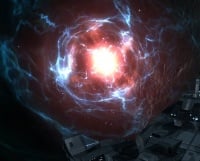
To move longer distances within solar systems, ships use warp drives. Starting warp requires a destination object with mass or feigned mass. The ship will acquire this object as a target and use its warp drive in conjunction with sub-lightspeed thrusters to accelerate through a warp tunnel.
To travel the great distances between solar systems, ships use stargates, wormholes, and certain types of filament. Capital class ships can also use built-in jump drives to travel these great distances, by locking onto the beacon of a cynosural field at their destination.
All ships except supercapitals can be built in and docked in stations. Most ships have a cargo hold, many ships have drone bays, and some ships have specialized cargoholds, ship maintenance bays and fuel bays.
Skills
Spaceship command skills
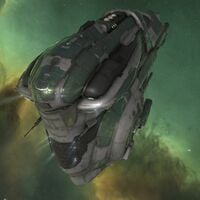
To fly ships in EVE, a character must train the relevant skills in the Spaceship Command skill category. This category is not to be confused with the general skill Spaceship Command.
The skills for larger hull types and higher tech levels usually require some skill training in smaller hull types or lower tech levels first. To fly a Tech 1 cruiser, for instance, you must first have some training in a Tech 1 destroyer command skill. Likewise, the skills for Tech 2 frigates require perfecting the Tech 1 frigate command skills.
In most cases, the prerequisites for flying bigger ships (by hull type) are faster to train than the prerequisites for higher tech levels. As a result, newer pilots may find themselves in large T1 ships (battlecruisers or battleships) long before they can fly a T2 ship of any size. This is not a hard-and-fast rule, though: it's reasonable to train straight from Tech 1 frigates into Tech 2 frigates, for instance, without ever training the skills required to fly larger Tech 1 ships, if that is your goal as a pilot.
Support skills
- Main article: Support skills
Being able to fly a ship at all and being able to fly a ship well can be two very different things. While the relevant spaceship command skill may let you enter a ship and undock it from a station, this is only the first step to using the ship properly. In addition to the skills you will need to fit all of the guns and modules you want to use (fitting skills), there is an entire suite of support skills that can cumulatively boost a hull's performance. Some of these benefit most or all ships that you can fly, making them valuable training choices.
As a rule of thumb, smaller and lower-tech ships demand less-polished support and fitting skills from your character. A Tech 1 frigate in the hands of a days-old character can handily complete Level 1 PvE missions or significantly affect veteran pilots in advanced ships by tackling or using electronic warfare in PvP. An expensive Tech 2 black ops battleship, meanwhile, will be a painful loss waiting to happen if piloted by a character without well-trained support skills.
Small- and medium-sized Tech 1 hulls can take part in most activities in EVE, and even players with high-SP characters often return to these "basic" ships, so new players should bear support skills in mind but should not be daunted by the thought of training them. EVE University's Short Skill Plan and Pyramid Skill Plan might help players plan skill training in the short and long terms, respectively.
Fitting
- Main article: Fitting ships
Ships are merely empty hulls waiting to be equipped with the guns and modules that let them do their job. The process of equipping a ship is known as "fitting" the ship and is an expansive topic.
However, one basic concept is worth mentioning here as it ties into the ship sizes listed earlier. The ship sizes are grouped into small, medium, large, or X-large. When browsing the market, you will notice that modules and weapons are also grouped into these same sizes. When fitting a ship, you normally want to use modules and weapons that are in the same size grouping as the ship size. This can sometimes be confusing, especially with weapon systems, as many items may will say "medium" in the name, but belong to the "small" size group in the market categories. What matters for ship fitting is that the market category size group matches the ship size, not any terms found in the item name itself.
Categorization
Ships can be categorized in many ways, and this section will cover the most basic methods. The examples given are not a complete representation of ships in EVE. It should be noted, however, that more expensive or bigger doesn't always mean better in EVE.
Size Class
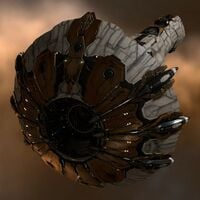
As ships increase in size they gain more hitpoints, potential damage output, and module slots. They lose agility, speed, and the ability to apply damage to smaller, faster targets. The sizes (with a few example ships) are as follows:
- Frigates:
 Incursus,
Incursus,  Heron,
Heron,  Crucifier,
Crucifier,  Burst
Burst - Destroyers:
 Algos,
Algos,  Corax,
Corax,  Coercer,
Coercer,  Thrasher
Thrasher - Cruisers:
 Thorax,
Thorax,  Caracal,
Caracal,  Maller,
Maller,  Scythe
Scythe - Battlecruisers:
 Myrmidon,
Myrmidon,  Ferox,
Ferox,  Harbinger,
Harbinger,  Hurricane
Hurricane - Battleships:
 Megathron,
Megathron,  Rokh,
Rokh,  Abaddon,
Abaddon,  Tempest
Tempest - Capital Ships:
 Rorqual,
Rorqual,  Anshar,
Anshar,  Charon
Charon
- Supercapitals
Some ships that don't fit or are hard to pin down in this classification are certain industrials and ORE Ships. A common simplification of this classification is calling carriers, dreadnoughts, supercarriers, titans and the Rorqual "capitals", while calling all other ships "sub-capitals".
Tech 1 ship class comparison table
This table is meant to provide a basic comparison of ship classes, showing how, for example, "bigger is slower, but has more fitting slots". Characteristics that vary widely have been omitted. For example, bonuses can make drone capacity or scan resolution much higher or lower on one kind of cruiser than another. These often turn out to be the characteristics that define unique uses for ships within a class, making a given ship "a drone cruiser", "an EWAR cruiser", "an exploration cruiser", and so on.
Note that the following numbers are averages; drawn from a sample of four ships in each class.
| Ship Class | Speed (m/sec) | Warp Speed (AU) | Time to Warp (sec) | Slots | Capacitor (GJ) | Signature Radius (m) |
|---|---|---|---|---|---|---|
| Shuttle | 500 | 5 | 2 | 0 | 250 | 25 |
| Frigate | 300-400 | 5 | 5 | 10 | 250-350 | 35-40 |
| Destroyer | 235-365 | 4.5 | 6-7 | 13 | 500-700 | 62-70 |
| Cruiser | 190-240 | 3 | 8-9 | 14 | 1250-1950 | 120-150 |
| Battlecruiser | 145-180 | 2.7 | 12 | 17 | 2300-3500 | 250-300 |
| Battleship | 89-130 | 2 | 15-20 | 19 | 5500-6500 | 330-470 |
Tech levels and factions
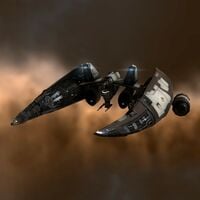
"Tech levels" refer to the complexity and rarity of the materials required to build a ship. Tech 1 ships are cheap and simple, but reliable; Tech 2 ships are expensive, powerful, but specialized; Tech 3 ships are expensive and highly flexible.
"Faction" origins indicate the NPC group within EVE responsible for the ship design. The standard ships of the four main NPC empires—Minmatar, Amarr, Gallente and Caldari—are the mainstay of the game and the most commonly-encountered. "Navy" ships are tuned-up, improved, and more expensive versions of existing hulls designed for the four empires' military forces. "Pirate" ships are hulls developed by outlaw groups such as the Guristas Pirates or paramilitaries such as Mordu's Legion. Sisters of EVE ships are considered "pirate" ships although the Sisters are not a criminal organization.
Here are some examples:
- Tech 1:
 Incursus,
Incursus,  Corax,
Corax,  Omen,
Omen,  Hurricane
Hurricane - Navy Faction:
 Brutix Navy Issue,
Brutix Navy Issue,  Raven Navy Issue,
Raven Navy Issue,  Imperial Navy Slicer,
Imperial Navy Slicer,  Republic Fleet Firetail
Republic Fleet Firetail - Pirate Faction:
 Vigilant,
Vigilant,  Gila,
Gila,  Bhaalgorn,
Bhaalgorn,  Dramiel
Dramiel - Tech 2:
 Ishtar,
Ishtar,  Hawk,
Hawk,  Paladin,
Paladin,  Sleipnir
Sleipnir - Tech 3:
 Hecate,
Hecate,  Tengu,
Tengu,  Confessor,
Confessor,  Loki
Loki
Tech 1 ships are the baseline for all other ships. Although they are the first ships every character uses, they remain useful even for advanced pilots. They are easily built with knowledge available to everyone in New Eden, using widely-available materials. They are cheap, and they insure quite well.
Navy faction ships are generally amped-up versions of their Tech 1 counterparts, usually with more CPU and powergrid for fitting, and a few more slots for modules. They typically sit somewhere between base Tech 1 hulls and Tech 2 hulls in their capabilities. Sometimes the base hull's bonuses are traded for others so, for example, the Drake Navy Issue which trades the Drake's damage resistance for better damage application. In some cases the hull's role changes: the Scythe is designed to boost other ships' shields, while the Scythe Fleet Issue is a damage-dealer. Navy ships are harder to acquire than their base hull equivalents, and accordingly are more expensive on the open market.
Pirate faction ships represent a greater advance on the abilities of base Tech 1 hulls. They require two separate spaceship command skills for different factions so, for example, the Angel Cartel Cynabal requires training in both Minmatar Cruiser and Gallente Cruiser. In return, though, each pirate hull has more powerful and unusual bonuses which often make them fly in surprising ways. The Gurista Gila, for example, launches only two drones, but can use those two to deal damage equivalent to ten drones. Similarly, the Serpentis Vindicator offers a unique combination of a stasis webifier bonus and massive damage output. Pirate faction ships are roughly as powerful as Tech 2 ships, and require fewer skills. They are accordingly very expensive.
Tech 2 ships are built by retrofitting Tech 1 ships, and while they take some features from their Tech 1 forms, the ways they fly and take advantage of fitting may be very different. They have higher resistance to damage and are typically much more specialized in their roles. Many special modules can only be fit on Tech 2 ships. The heavy Interdictor is a prime example of a Tech 2 ship filling a specialized role: it can use a special module to stop ships within a wide area from warping away—a unique ability—but it has more limited abilities in other areas. Tech 2 ships are powerful within their niches but are not automatically better than Tech 1 ships, or immune to attack from Tech 1 ships. Tech 2 ships require extensive skill training to fly but can be less expensive than Pirate Faction ships due to their simpler production.
Tech 3 ships were developed by the four empire factions by reverse-engineering Sleeper technology. They are known for their powerful defenses and great versatility, which come from a very wide variety of innate hull bonuses, generous fitting layouts, and unique ways to completely transform themselves on-the-fly. All materials required for Tech 3 ships come from wormhole space. As an example, a Legion can be fitted to be a heavily armored neuting ship, a heavy assault missile boat, or a more traditional laser boat; and may be active tanked, buffer tanked, or even able to cloak itself. Similarly, a Hecate can switch between different modes which can harden its defenses, increase its mobility, or let it deal damage at longer ranges.
Other factions
CONCORD, EDENCOM, the Society of Conscious Thought, and the Triglavian Collective all also have ships of their own. These ships follow completely different mechanics and skill sets than other ships and do not fit into the traditional tech and faction levels.
 CONCORD offers a trio of extremely flexible, extremely skill-intensive, highly-militarized covert ops ships.
CONCORD offers a trio of extremely flexible, extremely skill-intensive, highly-militarized covert ops ships. EDENCOM offers a curious, but very difficult to utilize, set of ships with "chain lightning" damage-dealing abilities.
EDENCOM offers a curious, but very difficult to utilize, set of ships with "chain lightning" damage-dealing abilities. The Triglavian Collective offers a wide selection of ships that utilize unique ramping-over-time weapons that can burn down targets well above their weight class.
The Triglavian Collective offers a wide selection of ships that utilize unique ramping-over-time weapons that can burn down targets well above their weight class. The SoCT offers a set of three ships with nearly limitless versatility and no skill requirements, offering new and veteran players alike a set of flexible hulls.
The SoCT offers a set of three ships with nearly limitless versatility and no skill requirements, offering new and veteran players alike a set of flexible hulls.
Non-combat ships
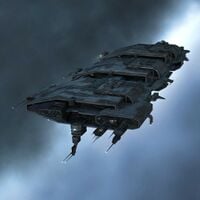
Not all ships are designed for aggressive action. A subset of ships with increased efficiency in resource-gathering and cargo hauling are in wide use across the EVE universe. Here is a loose listing of these ships.
Haulers
Haulers have large cargo capacities and are used to haul goods from place to place. Some are even more specialized, having an extra capacity for items such as ore, minerals or weapons. The smallest class of cargo ships, Tech 1 Haulers, are lightly defended and fly mostly among high security systems.
- Tech 1:
 Iteron Mark V,
Iteron Mark V,  Badger,
Badger,  Mammoth
Mammoth
Tech 2 haulers are divided between Blockade Runners, which are fast and can cloak for stealth in dangerous space, and Deep Space Transports, which have stronger defenses. Each EVE race has one of each kind of Tech 2 industrial.
Freighters
Freighters are the largest cargo ships in EVE. These slow-moving hulks have no high or medium equipment slots and depend entirely on their massive hulls for defense. In general, if you can package an item, you can fit it into the cargo hold of a Tech 1 freighter.
- Tech 1:
 Charon,
Charon,  Fenrir,
Fenrir,  Obelisk,
Obelisk,  Providence
Providence
Tech 2 freighters are called Jump Freighters. They have smaller cargo bays than Tech 1 freighters but can use both jump gates and cynosural fields. The latter makes them especially useful in null sec.
Miners
While not intended for combat, ships bonused for mining can mount light weapons or carry drones suitable for defense against belt pirates.
- Tech 1:
 Venture
Venture
The Mining Barges are usually the next step in the mining profession. Each of the three is bonused for a specific use in asteroid mining.
The Exhumers are the top of the line in specialized ore extractors. As with the Mining Barges, each is bonused for a specific use.
The Expedition Frigates specialize in ice and gas harvesting.
Specialty Ships
 Porpoise: The Porpoise is a mining command ship, bringing a larger cargo bay than other mining ships and the ability to improve the mining speeds of nearby allies.
Porpoise: The Porpoise is a mining command ship, bringing a larger cargo bay than other mining ships and the ability to improve the mining speeds of nearby allies.- {Sh|Orca}}: The big brother of the Porpoise, a much larger, more capable, and more resilient mining command platform, which also features an enormous cargo bay that lets it also act as a hauling ship.
 Noctis: The final word in salvaging, able to fit up to 8 high-power salvagers or long-range tractor beams.
Noctis: The final word in salvaging, able to fit up to 8 high-power salvagers or long-range tractor beams. Rorqual: The Capital Industrial Ship, the dreadnought and carrier of mining, and the final word in mining command. Extremely capable at mining, mining fleet support, defensive combat, and cargo hauling. Cannot be used in high-security space, very powerful in low- and null-security space.
Rorqual: The Capital Industrial Ship, the dreadnought and carrier of mining, and the final word in mining command. Extremely capable at mining, mining fleet support, defensive combat, and cargo hauling. Cannot be used in high-security space, very powerful in low- and null-security space. Sisters of EVE: the three SOE ships (Astero, Stratios, Nestor) are optimized for exploration. Each is bonused for scanning and hacking, and each has sufficient combat strength to either run PvE combat sites or hunt other exploration ships. They require both Amarr and Gallente spaceship skills, and to be used effectively they require solid scanning, drone skills, and armor skills.
Sisters of EVE: the three SOE ships (Astero, Stratios, Nestor) are optimized for exploration. Each is bonused for scanning and hacking, and each has sufficient combat strength to either run PvE combat sites or hunt other exploration ships. They require both Amarr and Gallente spaceship skills, and to be used effectively they require solid scanning, drone skills, and armor skills.










